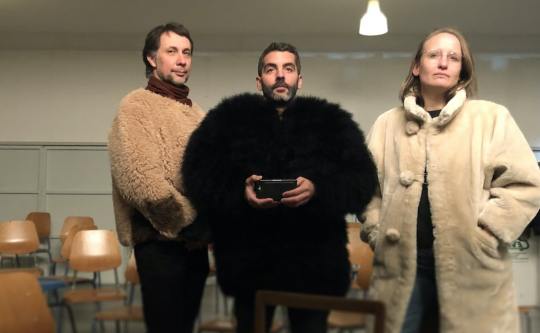|
While so many of us look to lyrics when we observe how songs can tell stories, often as not the real stories are in the music itself. If it’s a collective improvisation, there might be a narrative arc. Songs based on drone often add layers, subtly suggesting a change only noticed when the listener is immersed. These additions build to climax, finally letting the listener loose as the sounds subside.
The music on Meril Wubslin’s Alors Quoi has stories to tell. This is due to a sense of slow, brooding tension in these tracks, as if they give off a warning. There’s an undercurrent of panic in these gorgeously repeated, often guitar-driven riffs. The vocals, sometimes in chorus, float over the minimal chords like ghosts slithering in and out of cracks in long-abandoned buildings.

|
|
Meril Wubslin are a trio who hail from Lausanne, Switzerland and whose past recordings show a band at home inside meter-less space, harsher, icy sonic overload, and Velvets-like chug. In some ways, Alors Quoi continues this pattern. Yet it’s consistently lighter, more reliant on acoustic instrumentation, and might even fool a listener for a second or two into believing this is yet another Sahel-based desert guitar band. You hear it in “La-autour,” the album opener. The guitar pattern is brief, ever flowing, circular, with a single chord change. It’s hard to imagine this wasn’t inspired by Les Filles de Illighadad. The vocal harmonies waft over the riff as a keyboard line comes into the fore, portending who knows what future calamity before backing off in time for the vocals to reappear.

|
|
“La Traversee” rides a clipped, junk-yard riff alongside a kick drum and a hovering keyboard, the vocals, monotonic, dangerous in their lack of emotion, snuggle into this minimal stew. By and large, this is the formula for much of the record, yet no two tracks sound quite the same. However, this album invokes a mood and sustains it. Arguably, its ability to do this marks it as perhaps their most unified statement yet, and it’s also because of this that it tells the story that it does. One that seems to be set in spaces both bleak and wide open with characters whose indifference is what makes them so intriguing in the first place. Because of its slow creep, it can be connected to artists such as Ignatz, Bridget Hayden, or Julie Byrne. In other words, this is music that beckons the listener to come a little closer in order to truly hear the story it tells.
Find the artists online.
|
